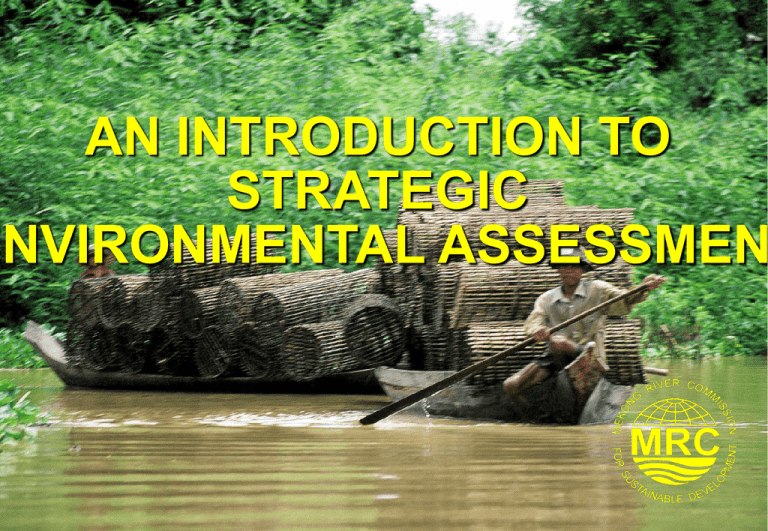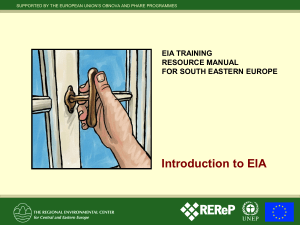AN INTRODUCTION TO STRATEGIC ENVIRONMENTAL ASSESSMENT Strategic Environmental Assessment
advertisement

AN INTRODUCTION TO STRATEGIC ENVIRONMENTAL ASSESSMEN Strategic Environmental Assessment 1 Course Learning Objectives At the end of this course you should be able to: Describe the elements of strategic environmental assessment (SEA) Describe the potential application of SEA in guiding development of regional policies, plans and programs (PPP) Illustrate by examples the use of SEA to evaluate resource use policy in individual riparian MRB countries and in a transboundary context Strategic Environmental Assessment 2 Lesson Learning Goals At the end of this lesson you should be able to: Define SEA and describe its potential application in assessing PPP Identify shortcomings of conventional project-level EIA and CEA which can be addressed using SEA Describe key steps in the SEA planning and implementation process Strategic Environmental Assessment 3 What is Strategic Environmental Assessment (SEA)? “A formalized, systematic, and comprehensive process for evaluating the environmental effects of a policy, plan or programme (PPP) and its alternatives.” (Therivel et al., 1992) Strategic Environmental Assessment 4 What is SEA? (Cont’d) The strategic component of a SEA refers to the set of objectives, principles and policies that give shape to the vision and development intentions incorporated in a policy, plan or program (PPP) SEAs deal with concepts and goals, not with particular activities SEAs aims to prevent unacceptable environmental damage Strategic Environmental Assessment 5 What are Policies, Plans and Programs? Policy: a general course of action or proposed overall direction that a government is, or will be implementing Plan: a purposeful, forward-looking strategy or design that elaborates and implements policy Program: a coherent, organized agency or schedule of commitments, proposals, instruments and/or activities that elaborates and implements policy Strategic Environmental Assessment 6 Distinction between SEA and Project-Level EIA SEA is broader in scope and used for strategic planning Project-level EIA addresses specific issues and impacts at specific locations SEAs do not replace project-level EIAs Project-level EIAs are necessary to provide detailed analysis Strategic Environmental Assessment 7 Need for SEA Promote sustainable development: by enhancing the integration of environmental concerns in policy and planning processes Address the limitations of Project EIA: even when cumulative effects are incorporated in project-level assessments some potential impacts will likely be overlooked Strategic Environmental Assessment 8 Why Assessment at the Policy Level is Important Increases the level of scrutiny of environmental and social concerns (i.e., to a comparable level as economic, technological, and financial considerations) Provides an opportunity to proactively guide development in ways that are sustainable (e.g., incorporate sustainability considerations into upper levels of decision making, increases opportunities to affect projects) Strategic Environmental Assessment 9 Why is Assessment at the Policy Level Important? (Cont’d) Provides an opportunity for genuine consideration of a broad range of alternatives which are often ignored or not feasible in project EIA (e.g., sites, technology, lifestyle choices, resource use) Improved analysis of cumulative, large-scale (i.e., regional, national and global), and nonproject impacts (e.g., agricultural practices) Strategic Environmental Assessment 10 Why is Assessment at the Policy Level Important? (Cont’d) Encourages consideration of environmental objectives within all government agencies (i.e., not just environmental departments) Facilitates and increases consultation between different government agencies Provides an opportunity to identify views of the public Strategic Environmental Assessment 11 Why is Assessment at the Policy Level Important? (Cont’d) Strengthens project-level EIA (i.e., limitations are due primarily to the relative late stage in decision making at which EIA takes place when only limited consideration can be given to the need of the project and alternative possibilities, or to the cumulative effects of related actions) Enhances efficiency via tiering (i.e., makes project specific EIA more efficient) Strategic Environmental Assessment 12 Tiering Tiering enhances efficiency by ensuring that proposed projects are consistent with the type of development already considered in the strategic environmental assessment Strategic Environmental Assessment 13 Comparative Features of Project-Level EIA and SEA EIA SEA Is reactive to a development proposal Is proactive and informs development proposals Assesses the effect of a proposed development on the environment Assesses the effect of the environment on development needs and opportunities Strategic Environmental Assessment 14 Comparative Features of Project-Level EIA and SEA (Cont’d) EIA SEA Addresses a specific Addresses area, regions project or sectors of development Has a well-defined beginning and end Strategic Environmental Assessment Is a continuous process 15 Comparative Features of Project-Level EIA and SEA (Cont’d) EIA Assesses direct impacts and benefits Focuses on the mitigation of impacts SEA Assesses cumulative impacts and identifies implications for sustainable development Focuses on maintaining a chosen level of environmental quality Strategic Environmental Assessment 16 Comparative Features of Project-Level EIA and SEA (Cont’d) EIA SEA Narrow perspective and a high level of detail Wide perspective and low level of detail Focus on projectspecific impacts Creates a vision and overall framework against which impacts and benefits can be measured Strategic Environmental Assessment 17 General Differences SEA occurs prior to project-level decision making SEAs are more variable in form and scope than project EIA wide range of strategic decisions to which SEA is applied from broad policies to specific plans SEA incorporates a greater scale of analysis (e.g., geographic area, environmental components considered, range of alternatives considered) Strategic Environmental Assessment 18 General Differences (Cont’d) Technical content and specificity are of lesser detail in a SEA Impact prediction uncertainties are greater for a SEA SEA may relate to geographical regions, industrial sectors or social issues Time scale is more variable in SEA (i.e., ranging from the immediate to the very long term) Strategic Environmental Assessment 19 Potential Uses of SEA Identify proactive strategies for pursuing sustainable development - identify options and opportunities Assist in evaluating the need and feasibility of government initiatives and proposals Evaluate environmental issues and impacts associated with policies, plans and programs Establishing an appropriate context for project EIA, including the early identification of issues and impacts that warrant detailed Strategicexamination Environmental Assessment 20 Application of SEA SEA can be applied to: Sectors (e.g., energy, tourism) Geographic areas (e.g., land use or development plans at various scales local, regional, national, international and global) Actions that do not give rise to projects but that may result in significant environmental impact (e.g., new technologies, privatization, agricultural practices) Strategic Environmental Assessment 21 Application of SEA (Cont’d) SEA occurs at all different scales from local regional global Different scales address different types of impacts (e.g., international-level SEAs focus on global issues while local SEAs address local issues) All SEAs address cumulative impacts Most common application of SEA has been the assessment of environmental impacts of land use plans at the municipal and regional level Strategic Environmental Assessment 22 SEA as a Tool For Environmental Planning Define goals and criteria Examine land-use trends for problems and ‘hot-spots’ Develop future scenarios Predict likely effects Evaluate impacts and value of alternatives Modify alternative goals with new constraints Strategic Environmental Assessment 23 Linkage Between Environmental Planning and SEA Objectives & Targets Identification of Priority Issues Actions (Strategies, Plans, Policies, Program) Evaluation of Options and Alternatives Monitoring & Evaluation Environmental Planning Strategic Environmental Assessment Assessment of Cumulative Effects SEA 24 Limited Use of SEA Potential advantages of SEA are well known, however, the use of SEA still remains relatively low Strategic Environmental Assessment 25 Barriers to Implementing SEA Lack of clear definition, established methodology and mechanisms for implementation Political resistance Difficulty defining when and how SEA should be applied (i.e., policies, plans and programs are generally nebulous, non-linear, complex and iterative making it difficult to know exactly what and when a policy should be assessed) Strategic Environmental Assessment 26 Barriers to Implementing SEA (Cont’d) Inherent complexity in analyzing policy impacts (e.g., high uncertainty, lack of knowledge, many and unclear cause and effect relationships) Tendency to apply assessment after policy has been developed Institutional difficulties in pursuing integrated policy and planning practices (e.g., difficulty in adopting holistic and broad scale thinking, inter-agency coordination, development of mutual policy) Strategic Environmental Assessment 27 Barriers to Implementing SEA (Cont’d) Uncertainty and technical limitations » since SEAs generally cover large areas, collecting and analyzing data is very complex » subject to greater levels of uncertainty » limited information available, specially when collecting data from different countries (e.g., determining ecological and socio-economic carrying capacities) Strategic Environmental Assessment 28 Barriers to Implementing SEA (Cont’d) Accepting short-term pain for long-term gain Lack of resources (e.g., information, expertise, financial) Lack of strategies for effectively involving the public Strategic Environmental Assessment 29 Requirements for Effective SEA Systems Political commitment and organizational support Clear provisions and requirements Use of appropriate methods Mechanisms for overview and monitoring, compliance and performance Follow-up and feedback capability Strategic Environmental Assessment 30 Concluding Thoughts Important points to remember are: Project-level EIA and CEA do not provide enough information to make environmental decisions on a regional, national or larger scale SEA offers a systematic process for evaluating the environmental consequences of PPP at an early stage of decision making Tiering of project-level EIA, CEA and SEA helps ensure that proposed projects are consistent with PPP Strategic Environmental Assessment 31


